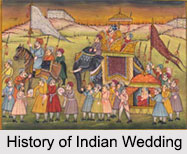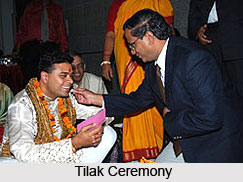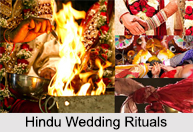 Hindu Wedding Rituals are many in number and involve not only the bride and groom but family members and even the community. A number of religious rites are there performed before and during the nuptials. Every marriage ritual has varying degrees of significance. However, there are regional and community variations.
Hindu Wedding Rituals are many in number and involve not only the bride and groom but family members and even the community. A number of religious rites are there performed before and during the nuptials. Every marriage ritual has varying degrees of significance. However, there are regional and community variations.
Hinduism believes that there are four stages of life and married life of Grihastha is the second stage. It is the time of life when two individuals come together and learn the actual values of life through the institution of marriage.
The various Hindu rituals performed during the wedding ceremony have emerged from the ceremonies and ancient customs that were practiced from the Vedic period. Even though, the customs and traditions differ from region to region yet, there are thirteen basic Hindu wedding rituals.
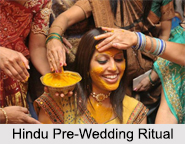 Hindu Pre-Wedding Rituals
Hindu Pre-Wedding Rituals
One of the earliest rituals is the Misri or "Ring Ceremony". It is a pre-wedding ceremony and involves oral agreement and "Lagna Patra" or written declaration. It proceeds with the "Mehendi Ceremony" and "Sangeet Ceremony". The custom of sangeet and mehendi has certain resemblance in the northern and western regions of the country. However, a marked difference is witnessed in the eastern and southern parts of India. Further, pre-marriage customs of "Sagri" (acquaintance) provides opportunity for the kith and kin of the bride and grooms to build a close bond. Each family member, who belong to the bride`s relations adorn the groom`s relatives with perfume, costumes and flowers.
The "Nav-Graha Puja" (Worship to the Nine Planets) is performed to ask for blessings from the Gods associated with the nine planets. "Ghari Puja" is the other essential pre -marital ritual where the priest performs prayers with rice, coconut, wheat grains, oil, betel nut, turmeric and other spices.
Hindu Wedding Rituals
The actual marriage ceremony begins with the ritual of the "Vara Satkaarah" in which the bridegroom and his friends and relatives are welcomed and received at the entrance of the hall where the wedding is to be conducted. The officiating priest chants mantras and the bride`s mother blesses the groom. She also applies a Tilak made of vermilion and turmeric powder on his forehead. This is followed by the "Madhuparka Ceremony" where the bridegroom is received at the altar and presents are given to him by the father of the bride. 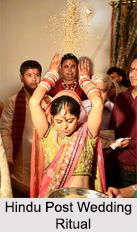
In the "Kanyadaan Ceremony", the father of the bride hands over his daughter to the bridegroom. The "Vivah Homa" follows which is the sacred fire ceremony. It is held to make sure that all the various holy ceremonies which are to take place are begun on a pure and spiritual note. In the ritual of the "Pani Grahan", the groom takes the right hand of the bride in his left hand and accepts her as his lawfully wedded wife.
The most important among the various ceremonies is the "Saptapadi". After the tying of the Mangalsutra, the Saptapadi is symbolised by the marriage knot, tying one end of the groom`s scarf with the bride`s dress. This is further carried with the seven steps representing nourishment, strength, prosperity, happiness, progeny, long life, harmony and understanding respectively. The manners in which these seven steps are taken may vary from region to region. For instance, in South Indian marriages, these seven steps are taken towards the Southern direction with the groom holding the right toe of the bride and then going round the sacred fire. In certain other marriages, the groom holds the hand of the bride and leads her around the fire seven times. Every step is taken invoking the Gods to shower their blessings on the couple. The last process in the Hindu wedding rituals includes the "Aashirvad" or benediction by the elders followed by the Vidai Ceremony.
Hindu Post Wedding Ritual
An integral part of every Indian wedding ceremony is the post wedding rituals. The merriment does not just stop with the bride"s departure to her husband"s home. One of the more important post Indian wedding rituals is the "Griha Pravesh", the time when the bride enters her husband"s home for the first time. Modern Indian weddings are usually characterized by the groom"s family hosting a Reception Ceremony. This gives well wishers, especially the ones who could not attend the wedding, a chance to give their blessings and best wishes to the new couple. These are some of the rituals, which sum up the post wedding functions.
Thus a traditional Hindu marriage comprises all these various rituals and customs.


















